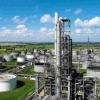I am currently sizing a new pump that will transfer oil from a production separator to tank.
While calculating the NPSH for the pump using the equation stated in API RP 14E, I find the term hvp which is the head loss due to the vapor pressure of the liquid.
I am using HYSYS, which value shall I used for the liquid? RVP or TVP?
I have thought of the True Vapor Pressure TVP but I found out that it's calculated at the same reference temperature as RVP!!
P.S:
- Pump Type is Reciprocating (i.e.acceleration head is applicable)
- Vessel Pressure is atmospheric and the RVP computed is 2 psia and the TVP computed is around 11.8 psia.
Which one shall I use? Please advise
|
|

Vapor Pressure For Npsh Calculation
Started by Sherif Morsi, Feb 22 2011 08:16 AM
3 replies to this topic
Share this topic:
#1

Posted 22 February 2011 - 08:16 AM
#2

Posted 22 February 2011 - 09:53 AM
You should use neither of the two, since they refer to the temperature that is not the actual vessel/fluid temperature.
There is a trick that can be applied in Hysys i.e. set the vessel liquid stream vapor fraction to zero (bubble point) and specify the actual temperature. The resultant pressure, as calculated by Hysys, is vapor pressure of the fluid at given temperature. If liquid in the vessel (that operates at atmospheric pressure) has lower vapor pressure than 1 atm, it means it is subcooled.
There is a trick that can be applied in Hysys i.e. set the vessel liquid stream vapor fraction to zero (bubble point) and specify the actual temperature. The resultant pressure, as calculated by Hysys, is vapor pressure of the fluid at given temperature. If liquid in the vessel (that operates at atmospheric pressure) has lower vapor pressure than 1 atm, it means it is subcooled.
#3

Posted 23 February 2011 - 04:09 AM
Does what you said apply for subcooled liquids as well?
Also, there is a say that the vapor pressure of the liquid leaving a vessel is equal to the operating pressure of the vessel. What do you think about this?
Thank you for your reply.
Also, there is a say that the vapor pressure of the liquid leaving a vessel is equal to the operating pressure of the vessel. What do you think about this?
Thank you for your reply.
#4

Posted 23 February 2011 - 10:21 AM
It applies for all liquids.
Your second question is actually the first one, just re-phrased: if the vessel contains subcooled liquid, then vapor pressure cannot be equal to the operating pressure. Example: storage of water @ 20 degC in the tank open to atmosphere. Is vapor pressure of water equal to 1 bar? No, it's not. It is the vapor pressure of water @ 20 degC.
Your second question is actually the first one, just re-phrased: if the vessel contains subcooled liquid, then vapor pressure cannot be equal to the operating pressure. Example: storage of water @ 20 degC in the tank open to atmosphere. Is vapor pressure of water equal to 1 bar? No, it's not. It is the vapor pressure of water @ 20 degC.
Similar Topics
Distillation Column Top PressureStarted by Guest_halkeshhulk_* , Yesterday, 01:52 PM |
|

|
||
Recommended Installation Location For "pressure High" InterlocStarted by Guest_omupei_* , 20 Jun 2025 |
|

|
||
Distillation Tower Top And Bottom Temperature And PressureStarted by Guest_student55_* , 27 Mar 2016 |
|
|
||
Steam Pressure In Heat ExchangerStarted by Guest_mvanrijnbach_* , 15 Apr 2025 |
|

|
||
Ammonia Line Vapor GenerationStarted by Guest_simadri_* , 07 Apr 2025 |
|

|

 FB
FB







